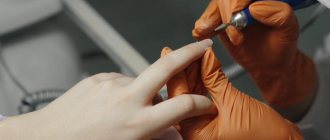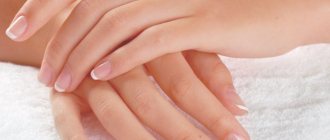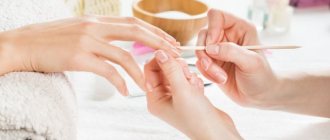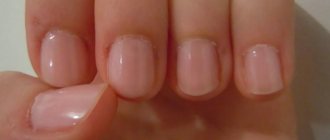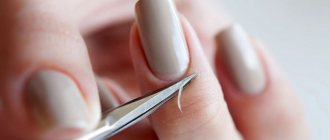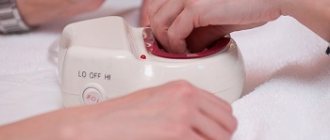A perfect manicure cannot be imagined without well-groomed, neat cuticles. You may be lucky and it grows slowly, but in any case, the growth of skin around the nail can cause unpleasant problems. Rough cuticles often crack, causing hangnails to appear; it makes the surface of the nail uneven, and what can we say about the durability of the coating - excess skin simply prevents good adhesion of the gel polish, varnish or gel to the nail. To avoid this, just clean your cuticles regularly. We'll tell you how to do it yourself at home.
You can remove the cuticle in two ways: do a classic manicure (trimmed) or a European manicure (untrimmed). At home it’s easier to turn to the second one. Let's start with it.
Modern means
Cuticles on your nails make your hands unkempt and untidy. It is very difficult to use cutters or scissors to cut it yourself. In addition, such a procedure is traumatic. A poorly treated wound can turn into an abscess and a source of infection. Therefore, recently women prefer unedged manicure. It is done much faster and does not have unpleasant consequences.
Which cuticle remover is best for home use? Global cosmetic brands are trying to solve this issue by producing oils, gels, and removers that allow you to painlessly, quickly and efficiently remove excess skin.
The essence of cuticle removal products without cutting is that, under the influence of the chemical composition, the rough areas of skin around the nails are softened. After this, it is removed using a spatula.
Of course, if you wish, you can prepare such a composition yourself, but not all ladies decide to undertake such experiments. Moreover, purchasing a ready-made product is not at all difficult. The advantage of an unedged manicure is the speed and ease of execution. There is no need to pre-do hot baths. In addition, after treating the cuticle with compounds, it grows much slower.
How and with what to remove
Of course, the easiest way is to go to a salon for professional help.
The master will be able to efficiently remove the cuticle and give a beautiful shape to the nails.
However, not everyone has the opportunity to afford such visits. That is why it is necessary to study information about performing the cuticle removal procedure yourself.
paramount importance . It’s better to find a visual video or “spy” on the work of a professional. In this case, it is necessary to take into account a number of nuances that affect the final result.
Important points when treating the nail plate:
- Be sure to treat the instrument with a disinfectant solution, even if used on a purely individual basis.
- The formation of the nail plate is carried out exclusively on a dry surface . If you use a file on wet nails, they will begin to peel.
- It is better to use glass, ceramic and specially coated files on a rubber or plastic base . It is better to avoid metal files.
- After the nails have taken the necessary configurations , you can begin processing the cuticle.
Read reviews on how to restore nails after shellac.
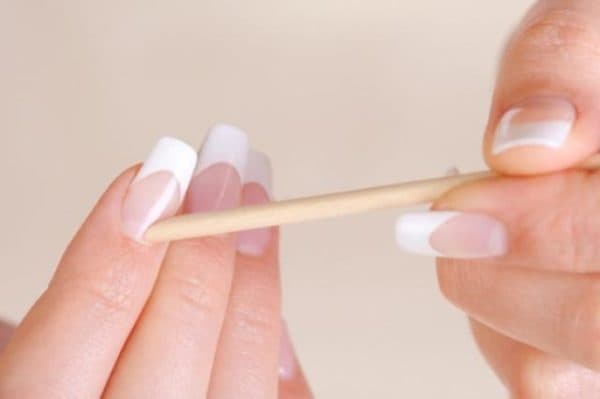
An important rule of any manicure is the use of quality tools. Preference should be given to medical steel and trusted manufacturers.
Of course, purchasing a high-quality manicure set will not be cheap, but this purchase will serve you well for many years.
Before performing a home manicure, you also need to take care of purchasing cuticle oil, and if you are a supporter of the untrimmed method, also about a special gel remover. Its functions are to soften and dissolve the cuticle skin, so this method is considered less traumatic than removal with scissors.
You will learn which lamp to choose for shellac from this article.
Tools
The trimmed type of manicure will also require the use of special devices.
There can be no categorical recommendations here, because the convenience of using one or another method depends solely on individual preferences.
What tool can you use to cut the cuticle?
- Scissors with thin sharp edges . Usually they are included in every manicure set. This is the “classic” way to remove cuticles. For ease of use, the scissors have a rounded edge.
- Cuticle nippers . It is also a necessary tool, less traumatic and safe. When choosing wire cutters, you must carefully inspect the blades for defects and possible malfunctions in the operation of the clutch mechanism.
- Special trimmer for cuticles . This handy tool is equipped with miniature fixed blades arranged in a V shape. It makes it very easy to remove cuticles without affecting the excess.
We have compiled a rating of professional cuticle nippers for you, it is here.
You also need to have an emollient cream or cuticle oil in your arsenal. They provide proper care and recovery after such manipulations.
On video: how to remove cuticles at home
Classic method
Cuticle removal can be done in the classic way. To do this you will need any of the above tools.
Before carrying out the procedure, it is advisable to steam the skin of your hands well, but many girls prefer to work dry. This is a matter of taste, but if the cuticle is extremely rough and overgrown, it is impossible to do without preliminary softening.
Execution algorithm:
- Steam your hands in a bath with sea salt or herbal infusions.
- Wipe dry with a towel.
- Using wooden manicure sticks, push a thin layer of skin away from the plate towards the nail bed.
- Trim the cuticles on the sides.
- Remove the layer of skin near the nail bed in an arc.
- Moisten the treated area with oil or cream.
It is advisable not to make sudden movements or grab the skin too much. Here it is better to retreat more than to accidentally injure the skin.
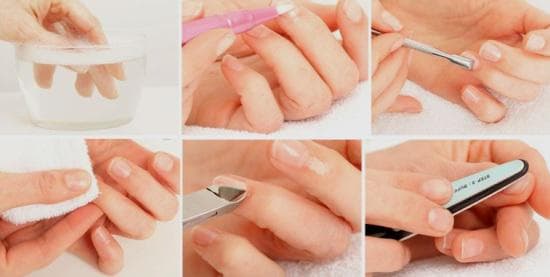
No tools
European manicure is performed exactly according to this scheme.
The main difference is absolute safety, because no cutting tool is used during the work.
This method is extremely popular in European countries, as it is hygienic. To perform this you will need a special gel – remover, which softens and dissolves the skin.
Algorithm of actions:
- Apply the product according to the manufacturer's instructions.
- Maintain the required time (usually 5 – 7 minutes).
- Use a wooden manicure stick to carefully remove the skin around the perimeter of the nail.
The procedure is simple and painless.
In addition, it can be repeated as needed up to three times a week.
Be sure to moisturize the treated area with oil or cream to provide the skin with the necessary care.
Find out which is the best cuticle remover gel.
Hardware manicure
Home manicure devices are not yet widespread, so this method remains practically unclaimed. At the same time, with the proper skill, such a device can completely replace the services of a master. A variety of attachments will allow you to perform all the necessary stages of creating a manicure efficiently and carefully.
To process cuticles, you will need a hard conical nozzle, which needs to go around the perimeter of the nail in one direction and the other. There is no need to press hard, and “finishing” processing can be done using a ball-shaped nozzle. Polishing of the nail plate is done with the softest one, which is presented in the set. With the proper skill, such cuticle removal will take incomparably less time. At the end of processing, you can use oil. Which cuticle oil is good and which scent is better, you will have to choose on your own, based on your skin type and your own preferences.
Video shows cuticle removal using hardware
Reasons for bubbling nail polish are here.
And a review of spray hair dyes in cans is here.
Rules for using funds
Any professional nail cuticle remover (or remover) has instructions for use. Following simple rules will allow you to get the desired result. Before purchasing a product, check its expiration dates. It contains very active substances that, if stored improperly, can cause skin burns.
Before using the products you must:
- Remove any remaining nail polish.
- Give your nails the desired shape.
- Wash your hands thoroughly with soap. If desired, you can make strengthening baths with salt.
- Check out the new product. To do this, apply it to only one finger. This will help identify allergies. The substance can be used only if there is no reaction on the skin.
- The product is applied to dry cuticles using a brush or applicator.
- You should not take breaks between applying the substance to different fingers.
- The substance must be kept on your hands for the amount of time specified in the instructions.
- Use a pusher to push back the softened cuticle.
- Use a napkin to remove any remaining product.
- Wash your hands well.
- Treat the cuticle with vitamin oil and apply moisturizer to your hands.
Cosmetic products for unedged manicure can be used no more than once a week. If you have sensitive skin, then you can use toxic substances no more than once every two weeks.
Removal without cutting
This method of removing cuticles is safer. The number of his fans is constantly increasing. Even a teenager who wants to take care of his hands on his own can master it. No injuries or cuts - everything is clean and tidy.
For a hygienic European manicure, you will need a cuticle remover and softener. They are called removers, and they come in different types:
- based on alkalis - they act quickly and effectively, but rather aggressively;
- with aggressive chemical acids - they are rarely freely available, more often they end up in salons where they are used for pedicures;
- based on delicate fruit acids - the best choice for home use; effectiveness depends on the characteristics of the skin and the manufacturer. Suitable for daily use. Marked with the abbreviation A.N.A. The product is available in the form of a gel or cream with a nozzle, a liquid with a brush, an aerosol or a pencil. You can find out what causes toenails to break by following this link.
Unedged method step by step
- Apply cosmetic product to prepared hands along the cuticles.
- The exposure time is indicated on the manufacturer's packaging. Usually it takes a few minutes - 5...7, sometimes until it dries.
- After the time has passed, remove excess remover with a napkin.
- Use a stick to push the cuticle away from the nail plate. After the procedure, it peels off well and is quite easy to remove.
- Wash your hands and apply moisturizer.
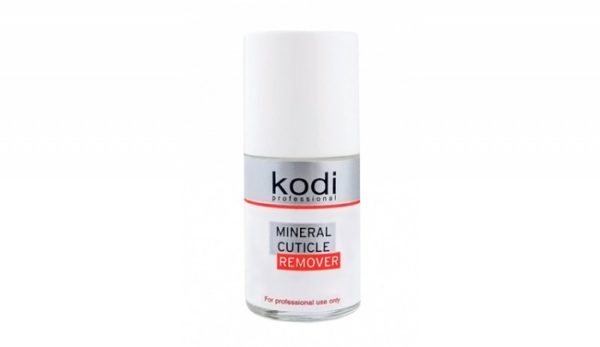
There are a huge number of cuticle removers, you can choose from 100 rubles and more
Products for unedged manicure cannot be called completely safe. They do not cause skin burns or irritate it, but have a negative effect on the nail plate itself. You should not use them more than 2…3 times a week. Manufacturers usually indicate this number on the packaging.
If you do the procedures more often, you can worsen the condition of your nails, and they will become brittle and weak.
Whatever cuticle removal method you choose, it is important to do the manipulations regularly. It is enough to take care of your cuticles once a week, remove dead skin particles and use skin softening products, and your hands will always look attractive. What you need to do to prevent your nails from peeling and breaking can be found in this material.
Cuticle remover gels
Many women ask the question: “Which cuticle remover is best to use at home?” Modern cosmetology offers removers, oil and gel. Most often, users choose all kinds of cuticle gels because they are quite effective, easy to use and fast-acting. Once applied to the skin, they begin to work quickly. After just a few minutes, the cuticle can be removed completely painlessly, and the remaining substance can be removed with napkins or by washing your hands. It is worth noting that gels can be selected depending on skin type. They can have a strong or medium effect. Also, different cosmetic products require different holding times on your hands.
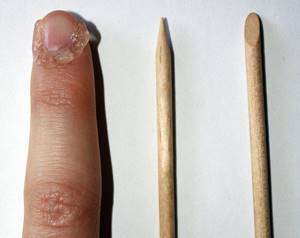
There are a variety of cuticle removers available on the market today. Which gel is better to use? It is very difficult to give a definite answer to this question. After trying several products, you can evaluate the effectiveness of each of them, choosing the best option for you. Among the most popular products are products from the brands Domix, Milv Goodbye, Sally Hansen.
How to properly remove cuticles at home using a device and scissors?
A combination manicure is also often used. This method is suitable if you have a device and scissors. In each case, a different option is selected, depending on the characteristics of the cuticle and its dryness.
Instructions:
- The combined removal method is suitable if you have wet cuticles and is very difficult to remove using a diamond-coated ball. When working with such skin, it tears; very often the master is forced to stop in one place, which leads to inflammation at the side ridges.
- In this case, we recommend removing the cuticle using a combined method. First you need to remove the pterygium and push back the cuticle using a truncated cone made of corundum, a flame cutter, a bullet, with a red notch.
- After this, the cutter is carried out almost perpendicular to the nail, without pressing on the plate. In this way the cuticle rises. Now you can carefully remove it using scissors or cuticle tweezers. Moisturizing and softening oil is applied.
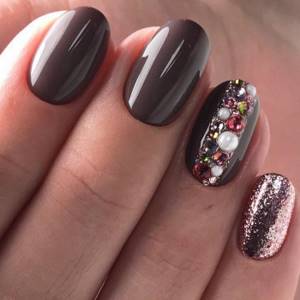
Beautiful manicure
Sally Hansen
If you don't know how to remove cuticles, it's better to use Sally Hansen. It differs from others in its composition. The gel contains anti-inflammatory components, alkalis and moisturizing ingredients. The product is fast-acting.
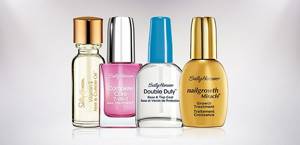
It should be kept on the skin for no more than a minute. The gel of this brand is most often chosen by owners of hard and dry cuticles, which were previously removed only by cutting. The product begins to act within 15 seconds after application. Therefore, at this moment you can begin to push back the cuticle. Afterwards, the product is washed off under warm running water, and hands are lubricated with nourishing cream.
Types of cuticle and choice of removal method
The removal method is chosen based on the type of cuticle. If you look closely, each person’s skin growths have a different shape, height and volume.
It is customary to distinguish three types of cuticles.
- It is characterized by a smooth transition of the nail fold into the cuticle; the roller itself is plastic, not dry.
Such skin is difficult to remove; it cannot be lifted with a spatula. The cuticle tissue looks “alive” and is never dry. The appearance of hangnails is still possible. This happens if the roller is touched with scissors or other cutting tools during processing. Manicurists remove it with scissors with rounded ends. You do not need to cut off the entire cuticle; a thin strip is left near the nail plate itself.
- The cuticle resembles a thin and transparent film, its tissues fit tightly, as if creeping onto the nail plate.
There is a clearly visible border between the cuticle and the roller. When visually examined, the roller itself is located above the cuticle. For this type, biological or unedged manicure is more suitable. The peel is easily removed with a wooden stick and cleaned with a mitral file. This cuticle is typical for fingernails, which are very peeling.
- The cuticle protrudes above the plate of the roller. This is clearly visible when looking at the nail from the side.
The film itself is hard and dry. Grooves, cracks and burrs may appear on it. It is more convenient to cut it with scissors; in difficult cases, a gentle manicure is performed. This cuticle is typical for ribbed fingernails.
Milv Goodbye Cuticles
How to remove cuticles for those with sensitive skin? In this case, we can recommend using the cosmetic product Milv Goodbye Cuticles. The hypoallergenic product quickly softens and dissolves dead skin. The gel simultaneously moisturizes and softens the skin, so the cuticle can be pushed back in just twenty seconds.
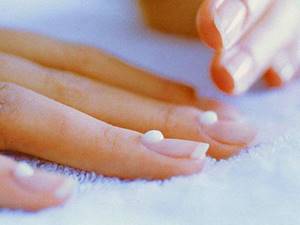
This product has a gel-like form. It is completely odorless and has a water base with the addition of glycerin. The composition contains antiseptic substances. After the procedure is completed, the remaining gel is removed with a napkin, after which the hands are washed in running water and lubricated with nourishing cream.
Trim manicure
This method is considered classic, which is what it is usually called. It consists in cutting the cuticle with special tweezers or scissors.
Don't forget that, like all procedures that involve breaking the integrity of the skin, manicures carry the risk of infections, some of which can be serious. At home, when we use tools only for ourselves, the risk is lower, but by no means zero, because germs and dirt can accumulate on the blades. That's why you should diligently disinfect them, and if you go to a salon, choose a professional who knows how to remove cuticles safely, whom you can trust and know that all devices will be properly sterilized.
If you don’t want to work on your hands at home, a master in the salon can also do a hardware-edged manicure using a machine and cutters. It is safer than the classic one and also saves time.
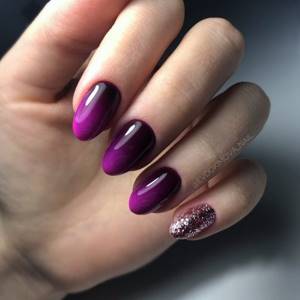
Sometimes these methods are combined by processing the rollers with a milling cutter and then with scissors or nippers. The combined manicure turns out to be especially neat.
How to remove cuticles with scissors
Manicure scissors are a convenient device for removing cuticles. Their curved blades follow the shape of the nail hole. Some women use razor blades. In my opinion, this is terrible, because it can hurt delicate skin.
How to remove cuticle step by step:
- Disinfect your tools. The technician at the salon uses an autoclave, but at home, wipe them with a strong alcohol solution.
- Steam your skin. For this, a warm bath with the addition of special compounds will be useful; or add baking soda at the rate of 1 teaspoon per liter of warm water.
- Dry your fingertips with a clean napkin.
- Now it's time to slightly lift and separate the cuticle while pushing it back. Use a stick for this. Carefully slide the roller off the nail.
- When the skin is lifted, it is easy to cut off. Start from the sides and end in the middle.
- If wounds accidentally appear during the process, treat them with hydrogen peroxide.
- Finally, apply cream or oil and massage lightly.
Removing cuticles with cuticle nippers
You can also use special nippers. The first steps in the instructions are the same as for removing with scissors: you need to disinfect the tool and steam your hands with a warm bath, then separate and lift the skin above the nail.
How to use the cutters:
- Place the lower blade under the skin roll.
- Pressing gently, “bite off” pieces of the skin, trying to cut off only its keratinized areas.
- If there are areas that don’t give in, don’t be too zealous, just move them away. This way you will avoid injury.
- Treat the nail holes with cream or oil.
Removers
If you don't know how to cut cuticles yourself, don't experiment. Better use a remover. This is the most popular and widespread way to get rid of dead skin. Its main advantage is simplicity.
How to use the remover:
- Hands are pre-cleaned, after which remover is applied to the area of the side rollers and cuticle. Next, we wait for the time indicated in the instructions. Depending on the brand, the exposure time varies from 30 seconds to several minutes.
- During the specified time, the cuticle softens, after which it can be easily removed without resorting to cutting. To work, you need to use a pusher or an orange stick. With the help of these instruments, the cuticle is pushed back, taking care not to disturb living areas of tissue.
- Hands are washed in running water, completely removing any remaining product.
- Afterwards, a special product is applied to the side rollers and cuticle, which will soften the skin and slow down the growth of the cuticle.
With the help of a remover you can make your hands attractive in a matter of minutes. Using modern tools, you will forget about how to trim the cuticle with scissors and tweezers.
The effect of gels and removers is almost the same. By the way, sometimes the gel can act as a remover.
Orange stick to the rescue
The method is similar to grandma's, but instead of a towel you need to use an orange stick. This manicure tool is made of orange wood, which is famous for its antiseptic properties. The stick is sharp on one side and flat on the other. The tool does not damage the skin, unlike iron manicure accessories.
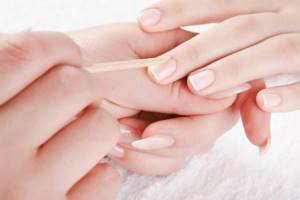
Use an orange stick daily to combat cuticles (Photo: xpresent.ru)
To forget about the cuticle forever, you should remove it every day after a shower with an orange stick. The cuticle is lifted with the flat side of the stick and then moved towards the base of the nail.
The softened skin comes off easily, but we must not forget about accuracy: you only need to move back that part of the cuticle that can be treated. Do not overdo it and achieve a perfectly clean nail plate the first time. By repeating the procedure daily, you will get the long-awaited result.
Which remover should you choose?
The choice of funds on the market is quite wide. Good removers are produced by the brands “Smart Enamel” and Be Natural.

“Wine enamel” differs from other products in that it destroys dead skin at the molecular level. The rapid action of the product is explained by the presence of sodium hydroxide in it. This brand of remover is good for gentle removal. However, it will not work if you have dry and rough cuticles.
Be Natural is a very effective remedy that quickly copes with even the most advanced cases. The substance is enough to act for only 45 seconds. The advantage of the remover is that it does not harm the nails, despite the serious chemical composition. Moreover, the product has nourishing and moisturizing properties.
Functions of the cuticle
The cuticle is the thin skin that frames the plate in the area of the nail bed.
It consists of two parts. Directly next to the nail is the eponychium , which plays a large role in the process of protecting the nail from external influences.
The visible part of the cuticle is called the pterygium . It is a keratinized layer of cells that can no longer perform a protective function.
It is this part of the cuticle that is removed, because it can cause hangnails and damage to the skin.
In addition, this “extra” skin does not look very aesthetically pleasing and can make you look unkempt.
Why is a cuticle necessary:
- Prevents the penetration of spores of fungal infections.
- Protects the nail from foreign objects getting inside.
- Prevents the penetration of harmful microorganisms.
If the dead edge of the cuticle is not trimmed in time, its beneficial functions become rather doubtful. Overgrown skin can be easily damaged even during everyday activities, and inflammation may occur at the site of cracks.
That is why it is necessary to carefully care for this area by regularly performing hygienic manicures.
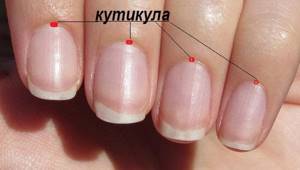
Find out from our article about the causes of brittle nails.
Chapped lips, read this article about what to do at home.
Watch a video about the effects of shellac on nails https://ilcosmetic.ru/uhod-za-nogtyami/laki/belye-pyatna-posle-shellaka.html
Types of removers
Based on their composition, removers are divided into:
- Acidic - break down keratinized areas of the epithelium using fruit, lactic or other acids.
- Alkaline - used for treating rough areas. The exposure time depends on the concentration of active substances.
- Mineral - used to maintain previously treated cuticle in good condition. The product has a delicate effect.
- Oil remover not only softens, but also nourishes and moisturizes the skin, making your hands look well-groomed.
Removers are not as harmless as they may seem. They contain very aggressive substances. Initially, removers were used to remove acrylic nails and gel polishes. During the work, their softening properties were discovered. Therefore, cosmetologists began to use them for manicures. This is how the first removers appeared, which had a more gentle composition for the cuticle. By the way, the consistency of such products may be different. Manufacturers produce removers in the form of liquids, gels and even creams.

Important rules for caring for cuticles
Cuticle care takes a little time, and I am sure that any woman can treat it beautifully on her own. Follow simple rules:
- Don't let the handles get dirty, take care of them regularly, and complex manipulations won't be required.
- Apply caring oil daily.
- Do not pull or tear the burrs. I always carry tweezers and a small bottle of alcohol solution in my cosmetic bag to remove a hangnail as soon as it appears, and I advise you to do the same.
- Do not neglect the rules of disinfection!
- It's always better to underdo it. Do not apply excessive force or cut deep.
The choice of manicure type depends on personal preferences. I like the skin to be completely cut off, but when processing at home I prefer to just peel it off. Which option do you prefer? Do you agree that all the beauty of a manicure rests on a neat cuticle?
Removers: advantages and disadvantages
Gently removing cuticles using an orange stick and remover has a number of advantages:
- There is no need to pre-steam the skin.
- At minimal cost you can get a high-quality manicure in a short time.
- There is no risk of skin damage, burr formation, inflammation or infection.
Despite the ease of implementation of the technique and convenience, there are also disadvantages. The fact is that removers contain fruit acids that can cause allergies. Therefore, it is necessary to test the product on one area of the skin before starting the procedure. Removers do not always cope with rough skin.
Basic recommendations
Removing the cuticle is a very important moment, regardless of where the manicure is performed, on the hands or feet. Therefore, always try to follow this procedure correctly. And for this I will once again remind you of the simple rules.
- When doing a trim manicure, try not to get hurt.
- When using the gel for the first time, try it on one finger to rule out an allergic reaction.
- Try to buy gels with fruit acids and AHA labeling. Since their composition is enriched with vitamins A and E.
- Use two fingers at a time for processing.
- If the cuticle is very overgrown, first do a classic manicure, and then gradually switch to a European one.
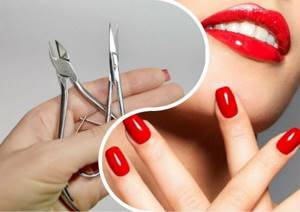
- When using the gel, consider your skin type. The soft cuticle will disappear on its own. But you will have to work hard on the hard one, removing the remainder with an orange stick.
- When working with tweezers, scissors or a trimmer, try to be extremely careful to prevent infection from entering the skin.
- Try to trim the cuticle as evenly as possible so that its partial remains cannot develop into painful hangnails.
Now, it seems, that’s all I wanted to talk about.
Happy manicure! See you!
Oils for unedged manicure
Cuticle oil is another effective remedy in the arsenal of modern women. With their help you can easily get rid of cuticles. The advantages of this product include the fact that it can be used for microcracks and inflammation around the nail. Oils not only nourish but also protect our hands. When using them, the skin is very easily removed, after which its growth slows down. The skin becomes more elastic and elastic, thereby preventing the appearance of hangnails.

Which cuticle oil should you choose? We suggest you pay attention to the following products:
1. Jess nail Cyticul oil. The oil softens rough skin while delivering nutrients to it. With regular use, after a while the skin becomes more tender and well-groomed, and the nail plate becomes stronger. Apply the oil with massage movements that increase blood flow. You should not use such products more than twice a month.
2. ORLY Cuticle oil. Many women leave good comments about this product. It contains cherry extract and orange flowers. All this allows you to saturate the skin with useful microelements and vitamins, as a result of which it becomes tender and soft. The use of this oil allows you to eliminate the appearance of hangnails and slow down the growth of the cuticle. In addition, the composition of the product has a beneficial effect on the nail plate, due to which it becomes stronger and grows faster.
3. Inki is another wonderful product that has a natural composition. It contains olive and castor oils, as well as propolis. Thanks to this, the skin becomes softer and the cuticle grows much slower. The product has a positive effect on the nail plate, strengthening it.
Do I need to remove the cuticle?
The outer part of the cuticle is made up of dead epithelial cells, so over time it becomes rougher, dries out, and may crack. Moreover, in some people, due to individual characteristics, it begins to “crawl” onto the nail plate, firmly attaching to it. As a result, tension is created, and the thin skin cracks, forming small wounds and burrs.
The problem lies not only in aesthetics:
- cracks can be very painful;
- burrs cling, causing discomfort;
- Contaminants and bacteria can enter wounds, causing inflammation.
In addition, an unkempt, overgrown cuticle spoils the appearance, causes a lot of discomfort and is frankly harmful to health. So, I am sure that it is advisable to remove it in a timely manner. There are several methods, which are divided into two types: edged (classical) and unedged (European) manicure.
Pencils
Cuticle oil in a pencil is multifunctional. With this product you can quickly remove rough skin without using other tools. According to users, there is nothing easier than using cuticle oil in a pencil. The product must be opened and treated with a rod on the rollers and cuticle. The substance contains oils and vitamins that slow down skin growth and improve the condition of nails. After some time, using a cap shaped like a pusher, you need to push back the cuticle.
Pencils are very convenient to use. They will be appreciated by all those women who want to have well-groomed hands, but at the same time cannot spend a lot of time on manicure. The advantage of the product is its delicate processing. The soft composition allows you to remove the cuticle, while simultaneously caring for the skin in this area, slowing down its growth. The pencils are multifunctional because they are equipped with a pusher. They are very convenient to use, and the risk of injury to the skin is minimized. It is worth noting that the product has no disadvantages. Among the shortcomings, one can highlight only a mild effect, which is less pronounced than that of removers. The pencil is not suitable for those with rough skin; more precisely, in this case, additional products will be needed to treat the cuticle.
On the other hand, oil preparations for hand care should be in the arsenal of any woman. They can be produced in various forms, but as practice has shown, pencils are the most convenient. You can put them in your purse because they take up very little space. These products can be used every day.
Judging by the reviews of women, a wonderful product in this category is the OPI oil stick. The oil is squeezed onto a brush, with which the substance is applied to the skin. Pencils are available in different scents, so you can choose the most suitable option for yourself. The oils included in the composition not only soften the cuticle, but also care for it. Positive reviews about the pencil indicate its effectiveness. And the convenient packaging allows you to use it very sparingly, squeezing individual portions of the product onto the brush.
Let's start with the basics
The cuticle is a soft, leathery edging of the nail plate, which is located at its base. According to its physiology, it specifically performs the functions assigned to it to protect the nail plate, protecting it from infection, bacteria or dirt.
However, as it grows, like any epithelial tissue, part of its cells, having fulfilled their functions, dies. Then they should be removed with a manicure. It can be done both in the salon and at home.
To independently perform such a cosmetic procedure, you should have certain tools and materials such as:
- Nail scissors with sharp tips;
- Trimmer, a small tool shaped like the letter V from the Latin alphabet with sharp inner edges to carefully remove rough skin;
- Traditional cuticle tweezers;
- Files, the surface of which resembles a solid or mesh honeycomb with plastic ends;
- Orange sticks;
- Pushera;
- A special pencil, similar to a nail polish brush or applicator, inside of which there is a nourishing oil, and on the outside there is a file for treating nails or cuticles;
- Remover gels;
- Hydrogen peroxide;
- Euro pumice, an innovative product made from a mixture of aluminum and phosphorus, which is used in cases where the gel is not effective.
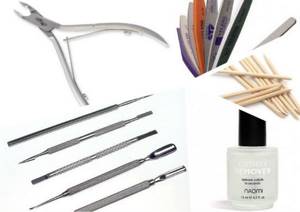
Cuticle file
Not long ago, special files for cutting cuticles appeared on sale. Using them at home is extremely simple - easier than pushers and removers.
The file must be held parallel to the skin and treated with light movements on the side ridges and cuticles. Movements should not be sudden so as not to damage living tissue. After processing, you must wash your hands thoroughly in running water and then apply special oil.
The file has many advantages. It is simple and easy to use. To treat the skin with it, no preliminary steaming or softening of the skin is required. In addition, there is no need to expose the skin to active chemicals.
However, some experts believe that the nail file still has its drawbacks. Without the skills to work with it, you can damage delicate skin. You should not buy cheap nail files. The coating on it must be of high quality, otherwise you can get injured. High-quality nail files from trusted brands have a decent price. In general, the choice is yours.
Classic way
If you have never resorted to doing your own manicure before, then you should know that there are two methods of cuticle removal: classic and European.
The classic way to remove cuticles is the traditional method, the so-called trimmed manicure. To make your manicure as comfortable and quick as possible, you will need scissors with sharp tips, cuticle nippers, as well as a pusher or orange sticks, however, if all this is not at hand, the tools can be replaced.
Step by step on how to remove cuticles with scissors or tweezers
- Before starting the procedure, you need to treat the skin of your fingers and all devices with an antiseptic to avoid getting an unwanted infection, which can easily become infected by catching even a small area of skin.
- After steaming the cuticle, you need to wipe your hands with a towel.
- A pusher or an orange stick will help you remove the cuticle by pushing it back as far as possible.
- Next, you should thoroughly clean the nail plate from the cuticle. To do this, you need to carefully push it aside and lift it a little. If you haven't done this before, don't worry: steamed cuticles are easy to process.
- Use scissors and tweezers to remove excess skin. It will be more convenient to do this if you start trimming the cuticle from the sides and finish in the middle, because then the likelihood that you will do it evenly and the first time will be much higher.
- During the process, do not try to pull or pull back the cuticle, as this will be accompanied by painful sensations. If you start trimming a wide area of the cuticle at once, you may miscalculate and touch the living skin, so it is recommended to trim it in narrow strips.

photo from the site https://babyben.ru
- The keratinized areas on the side of the nail should be removed using forceps. Using them at this stage will be much more convenient than using scissors.
- After finishing your manicure, you need to apply oil or moisturizer to the cuticles to prevent drying.
- If you accidentally touch a healthy area of skin, the wound should be treated with peroxide.
Rules for removing cuticles with cuticle nippers
You can add aesthetics to your hands by using nail clippers instead of nail scissors. This option is considered the simplest, especially if you are doing a manicure for the first time.
- The cutters are metal, so they must be disinfected before use.
- Press the handles to open the cutters. Place them in such a position that the lower blade passes under the steamed cuticle.
- The nippers do not need to be opened wide; on the contrary, their lower part should be firmly pressed to the nail plate, and the upper part should be at a distance of 1 mm. Lift the cuticle while “biting off” it. Thus, remove the cuticle along the entire nail arch.
- To prevent sudden movements, the nippers should rest against the index finger, while moving smoothly.
- If some part of the cuticle cannot be removed and remains on your fingers, do not be discouraged. It can serve as a protective layer against bacteria and infection. If it looks sloppy, you can move it towards the nail plate using a special stick.
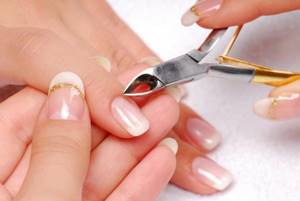
photo from the site https://kosmetsovet.com
The video at the end of the article will clearly demonstrate how to remove cuticles, in which a professional master will show several techniques and tell little secrets of quick and easy execution.
Preparing for the procedure - what needs to be done before removing dead skin
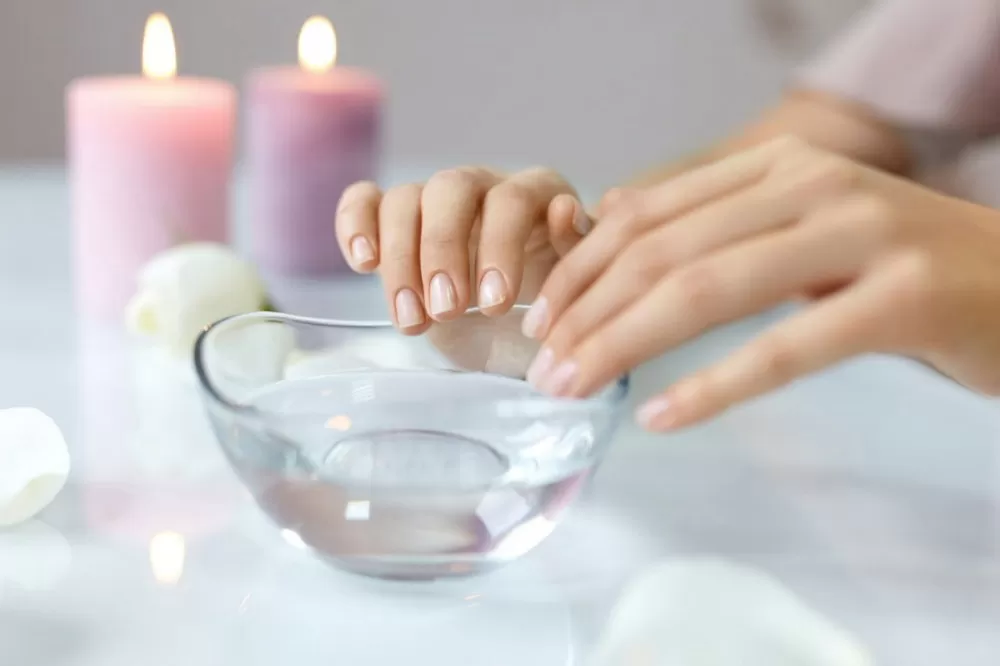
Whatever method you choose, before carrying out the procedure, it is advisable to prepare the tissue, that is, slightly soften the dead skin. You can do this in the following ways:
- Remove nail polish and decorative coating, if any. Pour tolerably hot water into a bowl, add sea salt. You can also add a little natural honey, soda, and lemon juice to the solution. These products will promote healthy tissue. Dip your hands into a container of water so that the liquid covers the first phalanges of the fingers. You need to keep your hands in the bath for 10-15 minutes.
- If after the bath the cuticle still remains hard and unyielding, apply a moisturizer or vegetable oil to the base of the nail plate. This can be regular cooking sunflower or olive oil. Or a product that is more beneficial for nails and skin is almond, coconut, or flaxseed oil.
It is recommended to remove the cuticle immediately after the procedure, before the skin becomes hard. Fingers need to be thoroughly dried, after which you can begin manicure.
Preparation for the procedure - drugs and accessories

The list of cosmetics that you may need if you are planning to remove film at home may vary. It all depends on what manicure technique you prefer. Below we list these techniques with detailed descriptions and step-by-step instructions. All you have to do is decide on the best option and prepare the necessary accessories for the procedure.
Tools, accessories and auxiliary items,
which you may need if you intend to remove cuticles yourself:
- Pusher or as it is simply called - pusher. This is a special double-sided manicure tool. At one end there is a small spatula that helps to move and remove the film. The second tip is sharp; it can be used to slightly pick up the skin in a hard-to-reach place or where it is poorly separated from the nail plate.
- An orange stick is a tool that allows you to remove cuticles using the least traumatic method. The orange tree is very soft and the stick is not capable of scratching the tissue or causing any other harm to it.
- Manicure scissors or tweezers that can be used to remove the film. These tools are used if you intend to use cutting manicure techniques. It is not recommended to use scissors for this purpose, as they can injure tissue if moved carelessly. They can easily cut off the excess so that blood comes out. This is fraught with infection and the development of inflammation. It is safer to remove cuticles using cuticle tweezers, but not everyone is comfortable using them. However, experts still recommend training and gaining experience in handling this tool.
- A small container, preferably ceramic, because this material retains heat well. You will need a bowl when preparing for the procedure. Then, before removing the film, you will soften it to make the manicure process easier.
- One of the preparations for softening the cuticle is cream, wax or vegetable oil, a special product for softening the skin.
- A product for inhibiting cuticle growth - having purchased such a drug, you will have to remove the film as little as possible.
- Medical glue BF-6 - this product will help stop bleeding if you break the integrity of the skin during the procedure. It is especially important to purchase this product if you are just learning how to remove cuticles yourself at home.
- Cotton swabs and pads - they will never be superfluous, as they help apply and remove cosmetics.
- Terry hand towel or paper napkins.
- The roller on which the hand is placed allows the procedure to be carried out in more comfortable conditions. The roller can be rolled up from a regular towel or purchased ready-made at a beauty supply store.
- Pharmaceutical preparations or alcohol for disinfecting hands and instruments. Since the cuticle is the dried edge of the roller that protects the nail plates from the penetration of pathogenic microorganisms, it should be removed only with sterile instruments. You can use an alcohol solution at a concentration of 70-90%, Chlorhexidine or special preparations for disinfection. Metal instruments can be additionally sterilized in an oven preheated to 250 degrees for 20 minutes.
After you finish removing the film, you can continue with the manicure to tidy up your nail plates. To do this, you will need nail files to shorten the length and give your nails a certain shape. And also buffs - special tools that are used to polish the surface of the nail plates.

